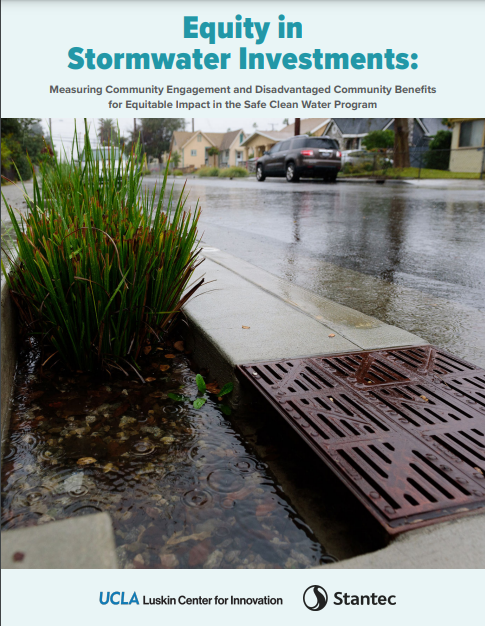The concept of environmental equity — ensuring that infrastructure investments benefit low-income neighborhoods as much as elsewhere within a service area — is a growing priority in the stormwater sector. As infrastructure managers scrutinize the ways they deliver projects under the lens of environmental equity, a new report spearheaded by researchers from the University of California, Los Angeles (UCLA) and Stantec (Los Angeles) argues that each step from conception to construction must center on comprehensive public engagement.
The report, commissioned by the Los Angeles County Flood Control District and released in August, focuses on the district’s Safe Clean Water Program (SCWP). The SCWP allocates funds from Measure W, a voluntary parcel tax to support stormwater management projects voted into law by Los Angeles voters in 2018, to build new stormwater infrastructure with a predominant focus on low-income communities. After conducting workshops and analyzing 116 SCWP projects funded by Measure W revenue since 2018, report authors recommend specific ways to enhance the program’s ability to support environmental equity. Although the report concentrates on the SCWP, authors contend that its conclusions about the value of public involvement can benefit equitable stormwater infrastructure spending in any setting.
“We found that community engagement is key to the program’s success in delivering benefits to disadvantaged communities,” Jon Christensen, UCLA sustainability researcher and co-author of the report, in a release. “It’s crucial that members of disadvantaged communities have the opportunity to identify those benefits for their own communities. It can’t just be a top-down process.”
Involving Locals in the Vetting Process
According to SCWP guidelines, infrastructure proposals that aim to directly improve water quality, water supply, or stormwater management in low-income communities receive a higher priority for funding. However, the report describes that these current guidelines lack specific provisions to ensure that such projects will directly benefit the communities they target, as well as whether the benefits they intend to provide align with the most pressing issues facing those communities.

Report authors outline an array of ways SCWP — as well as other stormwater funding programs — can better promote environmental equity at the foundational level.
For one, SCWP should strive to amplify the voices of residents living in the communities that potential infrastructure projects intend to target via new, formalized reporting processes. While modeling tools may indicate whether a neighborhood is particularly flood-prone, for example, they may fail to identify whether locals perceive flooding as a more pressing concern than water quality, water supply, or other priorities. To better inform decision-making, SCWP should embrace technology to provide easy ways for residents to report on their infrastructure needs as well as to compile and present this data alongside information from modeling tools, according to the report. Involving stated community needs as an integral part of the proposal-vetting process could lead to new and improved metrics by which to assess projects, such as how well a piece of infrastructure will align with the priorities of its community.
Going further, the report outlines that SCWP could create a process by which locals — either directly or through community-based organizations and non-profit groups — could approve or reject a proposal, making public acceptance of the project a requirement for construction to proceed. This approach would likely minimize public opposition and maximize buy-in, the authors describe.
“Robust community engagement takes work,” said Gregory Pierce, report co-author and co-director of the UCLA Luskin Center for Innovation, in a release. “Additional funding for community-based organizations, technical assistance, and program guidelines will help make this possible.”
Reaching the Most Vulnerable
Authors also suggest ways the SCWP can extend its reach by prioritizing projects in areas containing specific populations.
SCWP guidance currently considers any neighborhood in which the median annual household income is less than 80% of California’s statewide average as “disadvantaged,” a definition that covers approximately 42% of all census blocks in Los Angeles County. In effect, report authors describe, several projects have earned funding that may only indirectly benefit the city’s most vulnerable areas.
The report recommends an additional distinction, which would receive the highest priority during the project-vetting process, for proposals targeting the 21% of Los Angeles residents living in communities considered “severely disadvantaged”. This would include census blocks in which the average household earns 60% or less of the average statewide annual income. According to the authors, the Los Angeles County Flood Control District should also implement a formal policy statement that acknowledges and prioritizes SCWP investment in these severely disadvantaged communities.
Additionally, authors suggest that the district should specifically engage the various Native American nations located within its jurisdiction, which comprise approximately 150,000 people. This could include, for example, refining land use and land management policies to promote improved government-to-government relations and expediting infrastructure projects that would benefit these communities.
Read the full report, “Equity in Stormwater Investments: Measuring Community Engagement and Disadvantaged Community Benefits for Equitable Impact in the Safe Clean Water Program,” at the website of the UCLA Luskin Center for Innovation.
Top image courtesy of Maxx Girr/Pixabay

ABOUT THE AUTHOR
Justin Jacques is editor of Stormwater Report and a staff member of the Water Environment Federation (WEF). In addition to writing for WEF’s online publications, he also contributes to Water Environment & Technology magazine. Contact him at jjacques@wef.org.






